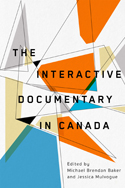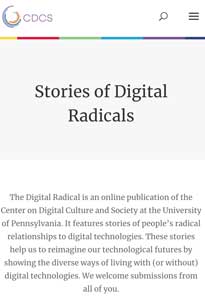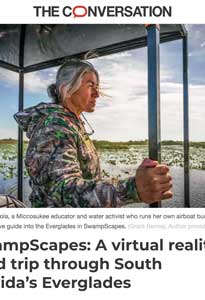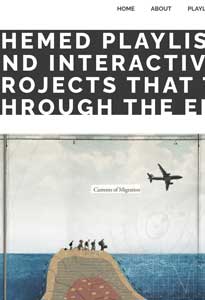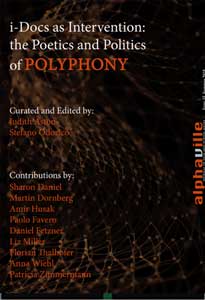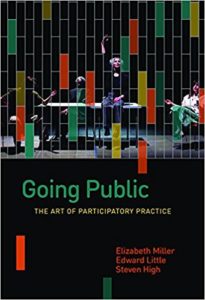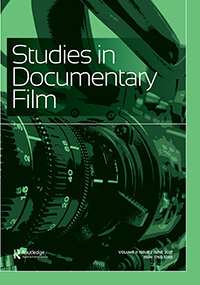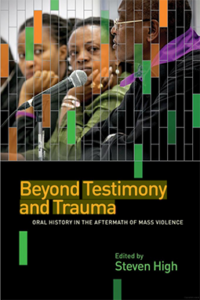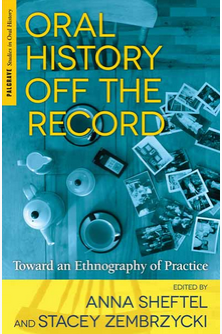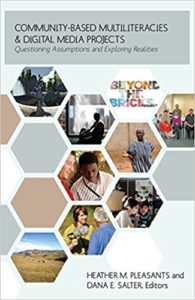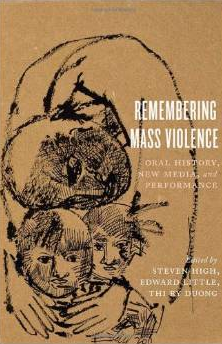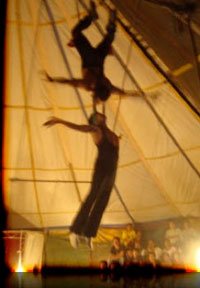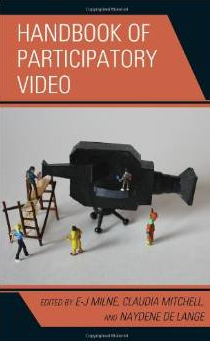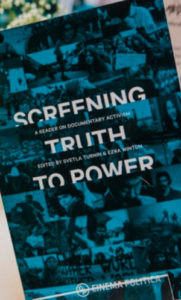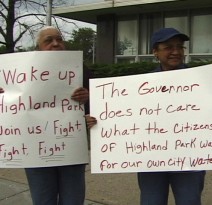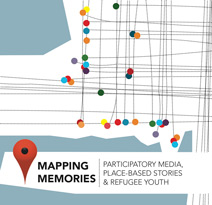Collaborative Encounters: I-Docs and Environmental Pedagogy In and Beyond the Classroom (2024)
Reference: Miller, Liz and Rachel Webb Jekanowski, (2024) “Collaborative Encounters: I-Docs and Environmental Pedagogy In and Beyond the Classroom” in The Interactive Documentary in Canada, edited by Mike Baker and Jessica Mulvogue, McGill-Queen’s University Press.
Interrogating Power and Unsettling Place in Documentary VR (2023)
Reference: Miller, Liz and Aggie Ebrahimi Bazaz, (2023) “Interrogating Power and Unsettling Place in Documentary VR” in Constructions of the Real: Intersections of Practice and Theory in Documentary-Based Filmmaking, Ed, Kim Munro, Catherine Gough-Brady, Christine Rogers, University of Chicago Press.
https://intellectdiscover.com/content/books/9781789387438.c07?originator=authorOffprint&identity=33329762×tamp=20240412060201&signature=49c17ed0ed89f4312c1fe138098da2b5
My Two Families (2023)
Reference: Miller, Elizabeth (Liz) (2023) “My Two Families” Small Stories of War: Children, Youth, and Conflict in Canada and Beyond, Ed. Barbara Lorenzkowski, Kristine Alexander, and Andrew Burtch, McGill-Queen’s University Press.
WasteScapes: Using Locative to Augment Waste Pedagogies in Place (2022)
Reference: Miller, Liz (2022), “WasteScapes: Using Locative to Augment Waste Pedagogies in Place,” Editor Eszter Zimanyi, Spectator: The University of Southern California Journal of Film and Television Criticism. 42.2 (Spring 2022): 45-53 / http://www.spectatorjournal.org
Invited and Implicated: Toward Critical Reflexivity in Non-fiction VR (2020)
As documentary filmmakers, the concept of power is essential to how we think about shaping and telling stories. We consider ourselves digital radicals because we both proceed from a commitment to critical reflexivity as a means of leveraging documentary forms, techniques, and processes toward exposing and challenging power. We recently expanded our documentary practices to include 360-degree Virtual Reality (VR) documentary filmmaking.
SwampScapes: A virtual reality field trip through South Florida’s Everglades (2019)
Before cities there were swamps. Wetlands and swamps globally have been sacrificed to pave the way for housing, agriculture and industry. Urban developers and dwellers have largely overlooked the vital role that swamps play in buffering storms, capturing carbon, fostering life and filtering water.
Digital and Interactive Media Projects that Think Through the Environment, 2019
Dale Hudson and Patricia R. Zimmermann curated this playlist of digital and interactive documentaries. They write: “These documentaries do not offer representations of the environment. Instead, they inhabit new architectures of a myriad of interfaces, platforms, algorithms, codes to expand environmental epistemologies that think through the environment — a strategy that mobilizes heterogeneities, relationalities, and contingencies rather than binaries of human/nonhuman, nature/culture, renewable/nonrenewable.”
Elizabeth Miller’s The Shore Line is included in this playlist
The Shore Line as Polyphony in Practice: A Case Study, 2017
The Shore Line (2017) is a collaborative interactive documentary that features over forty individuals from nine countries who are confronting the threats of unsustainable development and extreme weather along our global coasts. In this case study, producer and director Elizabeth Miller discusses how the polyphonic attributes of i-docs are ideal for classrooms and how she designed the site with educators in mind. She defines polyphony as the creative engagement of voices, authors and forms towards a common objective and shares the strategies and challenges of engaging her target audience—teachers invested in sustainability.
Miller, E. (2018) “The Shore Line as Polyphany in Practice: A Case Study” Alpahville, Journal of Film and Screen Media, Issue 15, Summer, 2018.
Going Public: The Art of Participatory Practice, 2017
Going Public responds to the urgent need to expand current thinking on what it means to co-create and to actively involve the public in research activities. Drawing on conversations with over thirty practitioners across multiple cultures and disciplines, this book examines the ways in which oral historians, media producers, and theatre artists use art, stories, and participatory practices to engage creatively with their publics. It offers insights into concerns related to voice, appropriation, privilege, and the ethics of participation. The book has a companion website with films and interviews.
by
Choreographies of Collaboration: Social Engagement in Interactive Documentaries, 2016
This article analyzes new opportunities for using interactive non-linear documentary as social change interventions. Through a series of in-depth conversations with socially engaged Canadian directors, producers and distribution strategists, we discuss how they are reconfiguring their production and outreach in a rapidly shifting and increasingly collaborative media environment. We focus on three recent projects produced or co-produced by the National Film Board of Canada: Here at Home, Highrise and Fort McMoney.
Miller, L. and Marty Allor, (2016) Choreographies of Collaboration: Social Engagement in Interactive Documentaries, Studies in Documentary Film. Mar 2016, Vol. 10 Issue 1, p53-70.
On Tour with Mapping Memories: Sharing Refugee Youth Stories in Montreal Classrooms, 2015
Beyond Testimony and Trauma is part of a three-part trilogy, edited by Steven High. It is an invaluable class resource for anyone addressing history and the contemporary politics of sensitive stories. In “On Tour with Mapping Memories” we discuss the final stage of a five-year project that involved a regional tour of thirty high schools led by three youth participants from Rwanda and Zimbabwe. We explore the ethics of taking personal stories public and how digital stories can be activated in peer-to-peer education.
Miller, L and Michele Luchs, (2015) “On Tour with Mapping Memories: Sharing Refugee Youth Stories in Montreal Classrooms.” Beyond Testimony and Trauma: Oral History in the Aftermath of Mass Violence, University of British Columbia Press, p. 235-253
Going Places: Helping Youth with Refugee Experiences Take Their Stories Public, 2013
Oral History off the Record is an excellent resource on the complex ethical frameworks of oral history methods. In “Going Public”, I discuss the process of developing a youth-led, alternative bus tour, a “memoryscape” and the challenges of helping youth with sensitive stories take their stories public for the first time.
Miller, L. (2013). “Going Places: Helping Youth with Refugee Experiences Take Their Stories Public.” Oral History Off the Record: Toward an Ethnography of Practice, Anna Sheftel, Stacey Zembrzycki, eds. NY: Palgrave Macmillan, p. 113 -127.
Entry Point: Participatory Media-Making with Queer and Trans Refugees: Social Locations, Agendas and Thinking Structurally, 2014
This book is a great resource on the motivation, methods and ethics of community-based digital media projects. In “Entry Point” we discuss the story behind a participatory workshop with queer and trans refugees, a workshop with AGIR and the Mapping Memories project.
Lee, E. and Miller, L. (2014). “Entry Point: Participatory Media-Making with Queer and Trans Refugees: Social Locations, Agendas and Thinking Structurally” in Community-Based Multiliteracies & Digital Media Projects: Questioning Assumptions and Exploring Realities, Heather M. Pleasants and Dana E. Salter, eds. NY: Peter Lang, 2014, p. 45-64.
Arrival Stories: Using Media to Create Connections in a Refugee Residence, 2013
Through insightful articles by historians, survivors and artists, this book explores the intersection of oral history, new media, and performance studies and the challenge of representing war, genocide, and other violations of human rights in a variety of creative projects. In “Arrival Stories” we describe the process and methods of leading digital media workshops in a shelter for newcomers over the course of a year.
Miller L. and Michele Luchs (2013). “Arrival Stories: Using Media to Create Connections in a Refugee Residence”. Remembering Mass Violence: Oral History, New Media and Performance, Steven High, Edward Little and Thi Ry Duong (eds.), Toronto, University of Toronto Press, p. 184-200.
Filmmaker in Residence: The Digital Grandchild of Challenge for Change, 2009
This collection of essays is the most comprehensive resource for anyone interested in the history of Challenge for Change and community media in Canada. In “Filmmaker in Residence” I interview Katerina Cizek about her long-term residence in an inner-city hospital where she passionately re- envisions Challenge for Change in the digital era.
Miller, L. (2009) Filmmaker in Residence: The Digital Grandchild of Challenge for Change. In Waugh, T. (Ed). Challenge For Change / Societe Nouvelle (McGill University Press) p. 427-442.
Queer is In the Eye of the Newcomer: Mapping Performances of Place, 2010
This article describes the story and methods of two collaborative media projects with groups of LGBTQ youth with refugee experience in Toronto. The objectives of the projects were to challenge past performances of victimization, to help the youth involved articulate their identity in a new place, and to explore the advocacy potential in taking their personal stories public.
Miller, L. (2010) “Queer is In the Eye of the Newcomer: Mapping Performances of Place” InTensions, Issue 4.0 Fall.
Dissemination and Ownership of Knowledge, 2012
This book is a great resource, offering a variety of methods and approaches to participatory video practices. In our chapter we discuss how the dissemination of participatory media outcomes is an essential part of any participatory project. Inviting participants of collaborative projects to share their work and experiences with a broader public can be individually empowering and can also contribute to far-reaching social change.
Miller, L. & Michele Smith (2012 )“Dissemination and Ownership of Knowledge” in Handbook of Participatory Video AltaMira Press, August, p. 331-348
The Process of Place: Grassroots Documentary Screenings, 2014
This book on documentary activism offers an in-depth look at the work of Cinema Politica. There are also great reference lists in this book including Anarchist Films, Feminist Docs, Eco-Docs, African Docs, Aboriginal Politics, Latin American Docs and more. In “The Process of Place” Tom Waugh and I discuss how site and location impact the experience of Cinema Politica.
Miller, L and Waugh, T. (2014) “The Process of Place: Grassroots Documentary Screenings,” Screening Truth to Power: A Reader on Documentary Activism” Svetla Turnin and Ezra Winton, eds. Montreal: Cinema Politica, p. 35-45.
Building Participation in the Outreach for “The Water Front” 2009
In this essay I discuss how we used The Water Front documentary to raise awareness about water privatization.
Miller, L. “Building Participation in the Outreach for “The Water Front” film, “Journal of Canadian Studies, special edition, Sharing Authority: Community-University Collaboration in Oral History, Digital Storytelling, and Engaged Scholarship, Vol. 43, No. 1, Winter, 2009, p. 59-86.
Mapping Memories: Participatory Media, Place-Based Stories & Refugee Youth, 2011
This book explores the practical and ethical issues of launching participatory media projects around sensitive issues, and offers insights on using digital storytelling, mapping, video, photovoice, soundscapes, and oral history. It also explores the power of using personal stories to inspire audiences, counter biases, and build understanding in classrooms and communities. The book contains a collection of first-person narratives and videos by youth with refugee experiences and is accompanied by a website.
Eds, Miller, Liz with Michele Luchs. (2011) Mapping Memories: Participatory Media, Place-Based Stories & Refugee Youth, (Montreal: Self Published), 53. Also see www.mappingmemories.ca .

